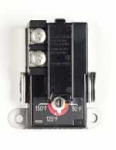Automatic Timers
Heat Traps
One simple step for reducing water-heating energy costs is lowering the thermostat setting on your water heater. Although some manufacturers set water heaters at 140 degrees F (60 degrees C), 120 degrees F (48.9 degrees C) is satisfactory for most household needs. Furthermore, when heated to 140 degrees F, water can pose a safety hazard (i.e., scalding). For each 10 degrees F (5.6 degrees C) reduction in water temperature, water-heating energy consumption can be reduced 3% to 5%.
 |
If your dishwasher does not have a booster heater, lowering the
water-heating temperature is not recommended. Also, many dishwasher detergents are
formulated to clean effectively at 140 degrees F and may not perform adequately at lower
temperatures. On gas water heaters, thermostats are usually visible. Electric water heaters, on the other hand, may have thermostats positioned behind screw-on plates. As a safety precaution, shut off electric current to the water heater before removing the plates. Keep in mind that electric water heaters may have two thermostats to adjust--one each for the upper and lower heating elements—and adjusting these is tricky. Talk to your local water-heating professional for help with this. |
When you plan to be away from home for an extended period of time (at least 3 days), turning the water heater thermostat down to the lowest setting, or even turning the heater off completely, can help you achieve additional savings. Be sure you know how to relight the pilot light on your gas heater, though, before you turn it off.
Automatic Timers
Another possibility for electric water heaters is installing a timer that can
automatically turn the heater off at night and on in the morning. At a $30 selling price
and a do-it-yourself installation, a simple timer may pay for itself in energy saved in
about 1 year. More expensive, multisetting timers are also available. Timers for gas water
heaters are not as useful or cost effective as those designed for electric water heaters.
This is because the pilot light supplies some heat during the night, offsetting some of
the energy savings achieved by using the timer.
Heat Traps
If heat traps were not initially installed with your water heater, adding them is another
way of reducing water-heating energy loss. Heat traps, or one-way valves, allow water to
flow into the tank and prevent unwanted hot-water flow out of the tank. Heat traps cost
about $30, but they may require professional installation, which could be expensive.
However, if installed at the same time as a new water heater, heat traps are much more
cost effective. Most new water heater models have factory installed traps, saving you the
time and expense of installing one yourself.
|
|
|
| Copyright Aclara Technologies LLC. All Rights Reserved. | |